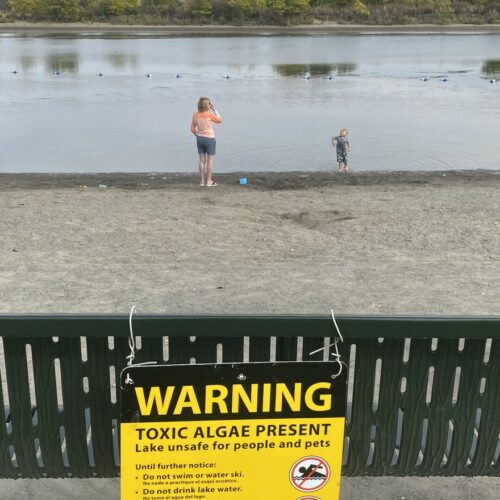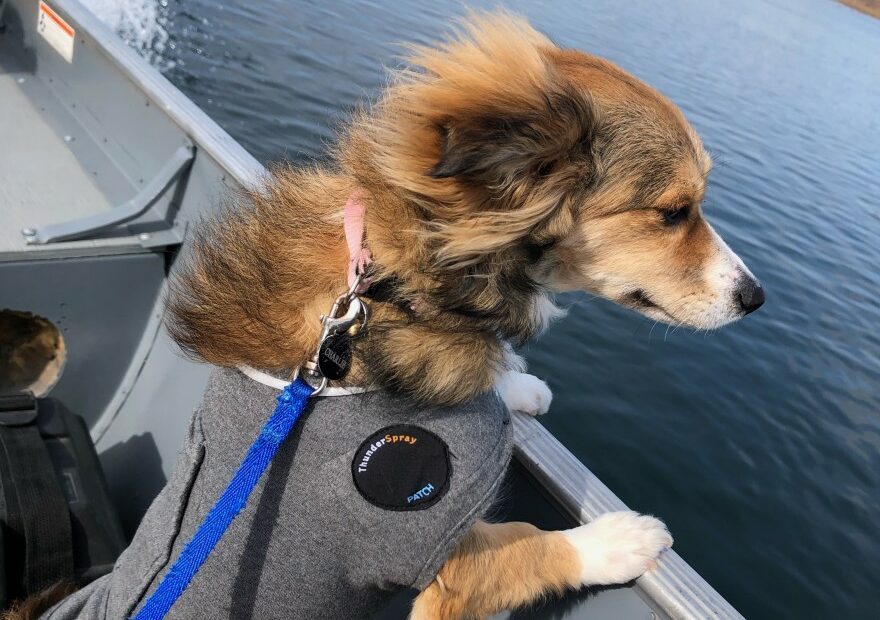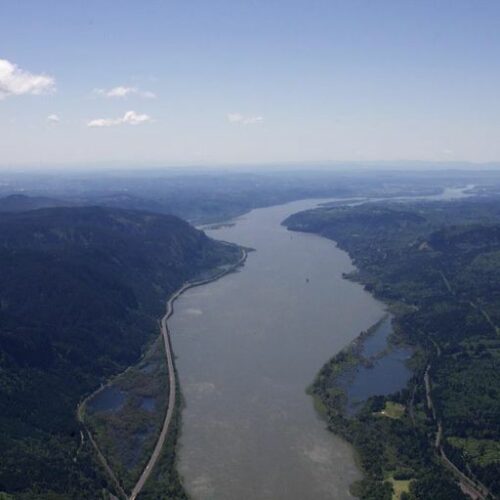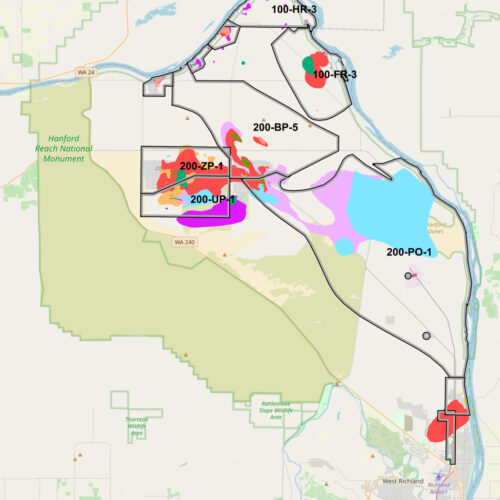Charlie was just nosing around in the Columbia River. Her family was off a beach they had visited many times before just north of Richland, Washington.
The young Terrier mix — weighing about 18 pounds — had been adopted from a shelter recently. After she put her face in the water Sunday, all of a sudden, Charlie started convulsing. The family quickly wrapped the dog in a towel and raced their boat back toward the Snyder Boat launch.
“I caught a glimpse of her at the launch as they lifted her out of the boat,” says Erin Dickey, of Richland, the adult daughter of the dog’s owners Janet and Tony Ogden of Richland. “She was limp. Her tongue was sticking out between her teeth and it was white. She might have been gone at that point.”
It took about less than an hour to get Charlie from the river’s edge to a vet in Pasco, but by then she was dead.
Since Monday five more pets have turned up sick or dead near the Tri-Cities. All are believed to have had recent contact with Columbia River water: Four have died. Two dogs were sickened, but survived.
The culprit? Toxic algae.
Richland Riverfront closed
Health officials now have closed the river shore from the boat launch at Howard Amon Park to the confluence of the Yakima River. The closure came after river water sample results from a King County lab showed the presence of Anatoxin-a — especially dangerous for small children and animals.
In a press release from Benton-Franklin Health District, officials say: “People and animals are exposed by ingesting the water. Symptoms appear within 15-20 minutes after ingestion depending upon the size of the person/animal affected and the amount of toxins consumed.
Exposure in animals may result in weakness, staggering, difficulty breathing, convulsions, and death.
In people, signs may include numbness of the lips, tingling in fingers and toes, and dizziness. Exposure to Anatoxin-a can be fatal.”
Officials also cautioned against eating fish caught near the Columbia River algae bloom.
Toxic algae is usually found in warm, slow moving water with elevated nutrients, such as fertilizer. According to University of Washington research scientist Ryan McCabe, Columbia River water levels at its mouth are the lowest seen since at least 1991.
“Data prior to that [1991] are pretty spotty, so not the greatest,” McCabe said in an email.
Record heat and widespread drought are likely playing a part, according to the state Department of Ecology. Low-flow rivers are acting more like lakes.
While that stretch of the Columbia is normally fast-flowing, the river and its tributaries are dammed from northern Washington, clear to Bonneville.
“The Columbia is a different beast,” McCabe says. “It’s a very regulated river.”
So what are Cyanotoxins?
Cyanotoxins are created by cyanobacteria, formally known as blue-green algae. It’s the goopy scum by the river or lake shore that comes in all sorts of colors.
Rick Dawson, an investigator and manager with the Benton-Franklin Health District, says sometimes it looks like paint has been drizzled in a lake or pond.
When a toxic algae blooms, it can create a toxin that kills pets, fish, wildlife, and sickens adults and children. Animals and people might even be able to breathe in the toxins — that’s under study.
“An animal is more likely to drink in a green slimy puddle, or a pond, or a contaminated source than a human would,” says Raelynn Farnsworth, interim director of Washington State University’s Veterinary Teaching Hospital. “It really depends on the exposure, what kind of toxin has been produced, but we don’t know that by looking visually. If you see a grossly contaminated pond, don’t let them [pets] go there.”
Farnsworth also says that the problem can be devastating because it’s so quick — sometimes there’s no time to administer activated charcoal and supportive care.
“The faster they get them to the vet the better we are,” she says. “But if they’ve [pets] already ingested it [toxins] and it’s already absorbed there’s not much we can do.”
Algae toxins aren’t regulated by the Environmental Protection Agency for drinking water. Algae blooms are getting more common, which means cities like Salem, Oregon, and Northwest states must come up to speed quickly to control the substance in their drinking water sources.
Toxic algae blooms are mainly a problem from mid-July through October, when the sunlight increases, the waters warm and nutrients are available.
As the climate continues to warm, the Northwest will likely see lower snowpack levels, more hot dry springs and summers and more toxic algae blooms in warmer waters.
“There just isn’t enough staffing to deal with it,” says Joan Hardy, a toxicologist with the Washington State Department of Health. “Some local health jurisdictions are running on a thread — and they also have COVID to deal with — they just need some funding to deal with these blooms.”
Dead bats, fish and cattle
Bats and perch have shown up dead at Pass Lake, near Deception Pass. The lake also had very high readings of Anatoxin-a, a nerve toxin. And the bats showed signs of the same toxins in their bodies when they were examined and tested by state officials.
In southern Washington, the state Department of Agriculture and Oregon State University’s College of Veterinary Medicine have been looking into a half-dozen cattle that died recently in Wahkiakum County. The county borders the Columbia River. But it’s so-far unclear if the animals died from a toxic algae exposure.
“We [WSDA] were pulled in until it was determined not to be associated with a livestock disease,” Hector Castro, with Washington State’s Department of Agriculture said in a text.
More signs
Signs along the Columbia River shore in the Tri-Cities had been few and far between. Benton-Franklin Health District officials were mainly focusing on high-use areas and boat launches, but there were no signs yet in Spanish, Russian, German or other languages frequently heard near the river shore. And despite one sign attached low on a park bench near the City of Richland’s swim beach in north Richland, many swimmers with small children questioned there, were unaware there was any potential problem.
However, the state legislature and state Department of Health have funding to develop, print and distribute new signs across Washington to warn of toxic algae. Hardy says some 1,700 signs have been printed up and are being dispersed now across the state for use on bloom events.
How to stay safe
A common refrain with regard to toxic algae is: “When in doubt, stay out.”
Officials advise people to carefully inspect any water source they’re about to fish in, play near or enter. Even then, toxins can hide, collect in only one side of a water body or be hidden in sneaky algae mats under the surface.
In the Benton-Franklin press release officials warn that fish can accumulate toxin in their bodies — especially in their organs. Officials advise caution when eating fish caught near this bloom on the Columbia River.
Dog owners are encouraged to bring their own water sources for their animals to drink when hiking or hunting. Dogs can also lick toxins off their fur. And people should shower after swimming in a lake, stream, pond — as some compounds can cause a rash on skin. Small children and pets are especially vulnerable because they have lower body weights.
Erin Dickey wishes they’d known all that before last weekend so they could have protected their family’s small dog Charlie. She’s just thankful that the weather was cool the day of their tragic boating adventure and her two small children only played on the Columbia River sand.
“We have spent so many years going out on the Columbia River, to have our dog die on one of our outings, it just makes me really sad,” says Dickey. “The river is like my dad’s church, that’s where he goes for solace and recreation — to have that be the source of the tragedy is just really sad.”
More signs
Signs along the Columbia River shore in the Tri-Cities had been few and far between. Benton-Franklin Health District officials were mainly focusing on high-use areas and boat launches, but there were no signs yet in Spanish, Russian, German or other languages frequently heard near the river shore. And despite one sign attached low on a park bench near the City of Richland’s swim beach in north Richland, many swimmers with small children questioned there, were unaware there was any potential problem.
However, the state legislature and state Department of Health have funding to develop, print and distribute new signs across Washington to warn of toxic algae. Hardy says some 1,700 signs have been printed up and are being dispersed now across the state for use on bloom events.
How to stay safe
A common refrain with regard to toxic algae is: “When in doubt, stay out.”
Officials advise people to carefully inspect any water source they’re about to fish in, play near or enter. Even then, toxins can hide, collect in only one side of a water body or be hidden in sneaky algae mats under the surface.
In the Benton-Franklin press release officials warn that fish can accumulate toxin in their bodies — especially in their organs. Officials advise caution when eating fish caught near this bloom on the Columbia River.
Dog owners are encouraged to bring their own water sources for their animals to drink when hiking or hunting. Dogs can also lick toxins off their fur. And people should shower after swimming in a lake, stream, pond — as some compounds can cause a rash on skin. Small children and pets are especially vulnerable because they have lower body weights.
Erin Dickey wishes they’d known all that before last weekend so they could have protected their family’s small dog Charlie. She’s just thankful that the weather was cool the day of their tragic boating adventure and her two small children only played on the Columbia River sand.
“We have spent so many years going out on the Columbia River, to have our dog die on one of our outings, it just makes me really sad,” says Dickey. “The river is like my dad’s church, that’s where he goes for solace and recreation — to have that be the source of the tragedy is just really sad.”
More signs
Signs along the Columbia River shore in the Tri-Cities had been few and far between. Benton-Franklin Health District officials were mainly focusing on high-use areas and boat launches, but there were no signs yet in Spanish, Russian, German or other languages frequently heard near the river shore. And despite one sign attached low on a park bench near the City of Richland’s swim beach in north Richland, many swimmers with small children questioned there, were unaware there was any potential problem.
However, the state legislature and state Department of Health have funding to develop, print and distribute new signs across Washington to warn of toxic algae. Hardy says some 1,700 signs have been printed up and are being dispersed now across the state for use on bloom events.
How to stay safe
A common refrain with regard to toxic algae is: “When in doubt, stay out.”
Officials advise people to carefully inspect any water source they’re about to fish in, play near or enter. Even then, toxins can hide, collect in only one side of a water body or be hidden in sneaky algae mats under the surface.
In the Benton-Franklin press release officials warn that fish can accumulate toxin in their bodies — especially in their organs. Officials advise caution when eating fish caught near this bloom on the Columbia River.
Dog owners are encouraged to bring their own water sources for their animals to drink when hiking or hunting. Dogs can also lick toxins off their fur. And people should shower after swimming in a lake, stream, pond — as some compounds can cause a rash on skin. Small children and pets are especially vulnerable because they have lower body weights.
Erin Dickey wishes they’d known all that before last weekend so they could have protected their family’s small dog Charlie. She’s just thankful that the weather was cool the day of their tragic boating adventure and her two small children only played on the Columbia River sand.
“We have spent so many years going out on the Columbia River, to have our dog die on one of our outings, it just makes me really sad,” says Dickey. “The river is like my dad’s church, that’s where he goes for solace and recreation — to have that be the source of the tragedy is just really sad.”
More signs
Signs along the Columbia River shore in the Tri-Cities had been few and far between. Benton-Franklin Health District officials were mainly focusing on high-use areas and boat launches, but there were no signs yet in Spanish, Russian, German or other languages frequently heard near the river shore. And despite one sign attached low on a park bench near the City of Richland’s swim beach in north Richland, many swimmers with small children questioned there, were unaware there was any potential problem.
However, the state legislature and state Department of Health have funding to develop, print and distribute new signs across Washington to warn of toxic algae. Hardy says some 1,700 signs have been printed up and are being dispersed now across the state for use on bloom events.
How to stay safe
A common refrain with regard to toxic algae is: “When in doubt, stay out.”
Officials advise people to carefully inspect any water source they’re about to fish in, play near or enter. Even then, toxins can hide, collect in only one side of a water body or be hidden in sneaky algae mats under the surface.
In the Benton-Franklin press release officials warn that fish can accumulate toxin in their bodies — especially in their organs. Officials advise caution when eating fish caught near this bloom on the Columbia River.
Dog owners are encouraged to bring their own water sources for their animals to drink when hiking or hunting. Dogs can also lick toxins off their fur. And people should shower after swimming in a lake, stream, pond — as some compounds can cause a rash on skin. Small children and pets are especially vulnerable because they have lower body weights.
Erin Dickey wishes they’d known all that before last weekend so they could have protected their family’s small dog Charlie. She’s just thankful that the weather was cool the day of their tragic boating adventure and her two small children only played on the Columbia River sand.
“We have spent so many years going out on the Columbia River, to have our dog die on one of our outings, it just makes me really sad,” says Dickey. “The river is like my dad’s church, that’s where he goes for solace and recreation — to have that be the source of the tragedy is just really sad.”

A lone sign guards the swim beach near the Columbia River recently in the City of Richland. Benton-Franklin Health District officials say they are putting signs up as they get them from the State Department of Health. CREDIT: Andy Plymale
More signs
Signs along the Columbia River shore in the Tri-Cities had been few and far between. Benton-Franklin Health District officials were mainly focusing on high-use areas and boat launches, but there were no signs yet in Spanish, Russian, German or other languages frequently heard near the river shore. And despite one sign attached low on a park bench near the City of Richland’s swim beach in north Richland, many swimmers with small children questioned there, were unaware there was any potential problem.
However, the state legislature and state Department of Health have funding to develop, print and distribute new signs across Washington to warn of toxic algae. Hardy says some 1,700 signs have been printed up and are being dispersed now across the state for use on bloom events.
How to stay safe
A common refrain with regard to toxic algae is: “When in doubt, stay out.”
Officials advise people to carefully inspect any water source they’re about to fish in, play near or enter. Even then, toxins can hide, collect in only one side of a water body or be hidden in sneaky algae mats under the surface.
In the Benton-Franklin press release officials warn that fish can accumulate toxin in their bodies — especially in their organs. Officials advise caution when eating fish caught near this bloom on the Columbia River.
Dog owners are encouraged to bring their own water sources for their animals to drink when hiking or hunting. Dogs can also lick toxins off their fur. And people should shower after swimming in a lake, stream, pond — as some compounds can cause a rash on skin. Small children and pets are especially vulnerable because they have lower body weights.
Erin Dickey wishes they’d known all that before last weekend so they could have protected their family’s small dog Charlie. She’s just thankful that the weather was cool the day of their tragic boating adventure and her two small children only played on the Columbia River sand.
“We have spent so many years going out on the Columbia River, to have our dog die on one of our outings, it just makes me really sad,” says Dickey. “The river is like my dad’s church, that’s where he goes for solace and recreation — to have that be the source of the tragedy is just really sad.”




















